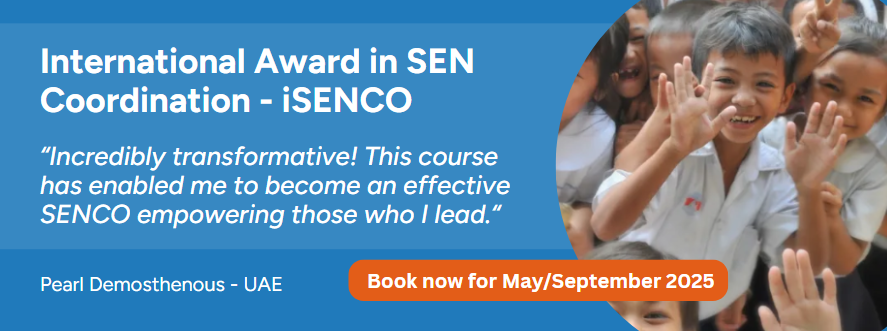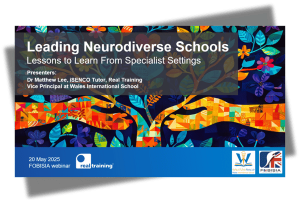What can mainstream schools learn from specialist settings when it comes to supporting children with special educational needs?
This was the question explored by Dr Matthew Lee, iSENCO tutor and Vice Principal at Wales International School in a recent webinar held in partnership with FOBISIA. Matthew draws on his experience working in both special and mainstream schools and first-hand knowledge of the benefits of structured routines, TEACCH techniques, PECS and specific social emotional strategies can bring to children with SEND.
Links to SEND resources mentioned in the presentation
- I am working towards cards – Twinkl available here
- TEACCH task boxes – Autism Adventures here
- Behavioural lanyards – Teachers Pay Teachers available here
- Visual supports for breathing – Teachers Pay Teachers available here
- Editable behaviour reflection lanyards – Twinkl available here
- Calm down kit – Autism Adventures here
- Now, next, then boards – Twinkl available here
- Take a break cards – Twinkl available here
Matthew’s booklist
The best book on supporting autistic students and playground adaptation: Practical Strategies for Supporting Emotional Regulation in Students with Autism: Enhancing Engagement and Learning in the Classroom, Leslie Blome and Maureen Zelle available here
Greenstein’s book is surprisingly good for statistical significance in special needs diagnosis: Radical Inclusive Education: Disability, teaching and struggles for liberation, Anat Greenstein – available here
Dan Goodley’s book in critical disability studies is well worth a read: Disability Studies: An Interdisciplinary Introduction, Dan Goodley available here
My PHD thesis exploring the experiences of parent perspectives on inclusive education in international schools can be found on the Lancaster University portal here
Your questions answered
What’s the most effective way to support neurodiverse learners without a diagnosis in mainstream settings?
Well it depends on the individual needs of the child. The strategies in the presentation were for emotional regulation and supporting children with low levels of verbal ability as these are two of the most difficult needs to integrate into the mainstream. The main principles would be building a structured routine, trying different strategies and personalising them to the child, utilising strategies across classes in the same way (same check in format, same language used by teachers at the start and end of lessons, same displays and scaffolds for emotional regulation available), and embracing what your setting defines as inclusion so that a long-term plan can be formulated with incremental steps.
How can we support kids with multiple disabilities transitioning from a specialist setting into the mainstream?
When we think about helping a child a transition from a specialist to a mainstream setting, the support needs to be based on the strategies the child was familiar with previously and recognising that the transition can only be a success if the mainstream adapts significantly to be more like the specialist environment. If it was highly structured utilising individual TEACCH stations, the child will need these for a time. If your school cannot provide this, then it’s not very inclusive to accept a child whose needs you cannot meet due to staff expertise etc. In Jordan, we built up long-term relationships with specialist providers who became feeder schools, and we knew we could implement then withdraw strategies they utilised, and the role of a learning support assistant was to implement the scaffolds the child was use to then gradually withdraw them and replace them with more independent strategies.
Any tips on developing whole-school buy-in for inclusion?
Every school is different so you need to analyse where your particular barriers lie (as well as what you are doing well), but also agree exactly how you are defining inclusion. All schools can become more inclusive, but I’ve yet to visit a school who said they are able to include every single child and the entire range of needs.
So it’s about understanding your vision for inclusion and then looking at barriers to achieving this – starting with and systemic barriers before you getting down to (potentially) individuals. When it comes to internal staff ask yourself; am I presuming that people are instantly going to respond negatively and not want to do the extra work that being more inclusive involves? This may not be the case. But even if it is, it’s your job as the SENCO to convince them otherwise. I tell everyone that yes it is extra work, but you will get a huge amount out of it, it terms of improving your overall pedagogy and becoming a much better teaching professional.
Make sure you are part of the SLT discussions and make sure every thing you do is inclusive by design – and not just for needs you see right now but for potential needs around the corner as well.





